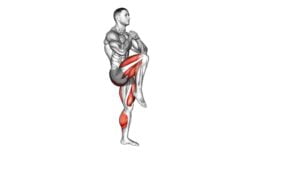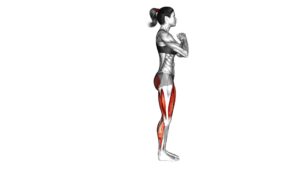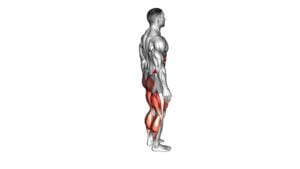Reverse Lunge High Knee (male) – Video Exercise Guide & Tips

Get ready to level up your workout with the reverse lunge high knee! This exercise targets your legs, glutes, and core while improving balance and coordination.
Watch This Exercise Video
In this video exercise guide, we will show you the proper form and technique, equipment needed, modifications for beginners, and tips to maximize your results.
Avoid common mistakes and get the most out of your workout. Let's get started and take your fitness to the next level!
Key Takeaways
- Reverse Lunge High Knee improves balance, coordination, and flexibility
- Proper form and technique are important for maximizing results and avoiding injury
- Modifications and progression options allow beginners to gradually increase difficulty
- Setting goals, tracking progress, and staying motivated are key to achieving desired results
Benefits of Reverse Lunge High Knee
You should frequently incorporate the reverse lunge high knee into your workout routine because it offers numerous benefits. This exercise is great for improving balance and increasing leg strength. By performing the reverse lunge high knee, you engage multiple muscle groups in your lower body, including your quadriceps, hamstrings, glutes, and calves. This helps to strengthen and tone your legs.
The reverse lunge high knee also challenges your balance and stability. As you step back into the lunge position and then bring your knee up towards your chest, you have to engage your core muscles to maintain proper form. This improves your overall balance and stability, which is important for everyday activities and sports performance.
In addition to improving balance and leg strength, the reverse lunge high knee can also help with coordination and flexibility. The movement requires coordination between your upper and lower body as you perform the lunge and then raise your knee. It also stretches your hip flexors and improves flexibility in your legs.
To incorporate the reverse lunge high knee into your workout routine, start by standing with your feet hip-width apart. Take a step back with one foot and lower your body into a lunge position. As you push back up, bring your back knee up towards your chest. Repeat on the other side.
Proper Form and Technique
Maintaining proper form and technique is crucial when performing the reverse lunge high knee exercise. To ensure you get the most out of this move and minimize the risk of injury, it's important to avoid common mistakes and implement effective workout strategies.
One common mistake to watch out for is leaning forward during the lunge. Keep your torso upright and engage your core to maintain stability.
Another mistake isn't stepping far enough back during the lunge, which can limit the effectiveness of the exercise. Take a big step back to ensure a deep lunge and activate the muscles in your legs and glutes.
To optimize your workout, focus on engaging your muscles throughout the entire movement. As you step back into the lunge, push through your front heel to activate your quadriceps and glutes. When driving your knee up, engage your core and hip flexors for maximum power.
A helpful workout strategy is to start with lighter weights or no weights at all until you have mastered the movement. This will allow you to focus on your form and technique without compromising your stability.
As you become more comfortable, gradually increase the weight to challenge your muscles further.
Equipment Needed for the Exercise
To perform the reverse lunge high knee exercise effectively, it's important to have the right equipment. Fortunately, you don't need any fancy or expensive gear for this exercise. All you need is a clear space to move around comfortably. Make sure you have enough room to take a step back and perform the lunge without any obstacles in your way.
Additionally, it can be helpful to have a mirror nearby so you can check your form and technique as you perform the exercise. This will allow you to make any necessary adjustments and ensure that you're executing the movement correctly.
When it comes to exercise variations, there are a few options you can consider. If you want to increase the intensity of the exercise, you can hold a pair of dumbbells or kettlebells in your hands while performing the reverse lunge high knee. This will add resistance and challenge your muscles even more.
Now that you know what equipment you need for the reverse lunge high knee exercise, let's move on to discussing some modifications for beginners.
Modifications for Beginners
If you're new to the reverse lunge high knee exercise, there are some simplified modifications you can try to make it easier.
For beginners, you can start by performing the reverse lunge without the high knee, focusing on getting the movement right.
As you progress, you can gradually add the high knee to challenge your balance and coordination.
Simplified Beginner Modifications
Your first step in incorporating simplified beginner modifications for the Reverse Lunge High Knee exercise is to focus on using your body's own resistance. As a beginner, it's important to start with basic variations that help you build strength and stability.
One simplified variation is to perform the exercise without any weights. Instead of holding dumbbells or a barbell, simply focus on the movement itself and engaging the muscles in your legs and core.
Another modification is to reduce the range of motion by taking smaller steps during the lunge and high knee movements. This allows you to maintain better balance and control.
By starting with these beginner modifications, you can gradually progress to more challenging variations as you build strength and confidence in your abilities.
Now let's explore some progression options for beginners.
Progression Options for Beginners
As you continue to incorporate simplified beginner modifications, you can progress your Reverse Lunge High Knee exercise by gradually adding weights or increasing the range of motion.
Adding weights can help increase the intensity and challenge your muscles further. Start by holding dumbbells or kettlebells in your hands while performing the exercise. You can also use a weighted vest or ankle weights to add resistance.
Another way to progress is by increasing the range of motion. Instead of just bringing your knee up to hip level, try bringing it up higher towards your chest. This will engage your core and leg muscles even more.
Remember to always listen to your body and only progress when you feel comfortable and ready.
Tips for Maximizing Results
To maximize your results with the reverse lunge high knee exercise, it's important to implement effective workout strategies and goal-setting techniques.
By varying the intensity and frequency of your workouts, you can challenge your muscles and promote greater strength and endurance.
Additionally, setting specific goals, such as increasing the number of repetitions or improving your form, can help you stay motivated and track your progress over time.
Effective Workout Strategies
For an effective workout strategy that maximizes your results, incorporate the reverse lunge high knee exercise into your routine. This exercise not only targets multiple muscle groups but also helps increase your workout intensity and improve time management.
Here are three tips to help you get the most out of this exercise:
- Engage your core: By keeping your core muscles activated throughout the exercise, you not only increase stability but also enhance overall balance and coordination.
- Maintain proper form: Make sure to keep your front knee aligned with your ankle and avoid letting it extend past your toes. This will help prevent unnecessary strain on your joints.
- Gradually increase difficulty: Start with a comfortable range of motion and gradually increase the depth of your lunge as you become more comfortable and stronger.
Goal-Setting Techniques
Maximize your results with goal-setting techniques for the reverse lunge high knee exercise. Setting goals is essential for staying motivated and achieving optimal results. Here are some goal-setting strategies to help you stay on track.
First, set specific and measurable goals. Instead of saying, 'I want to get in shape,' set a target like, 'I want to increase the number of reverse lunge high knee repetitions by 10 in two weeks.' This allows you to track your progress and stay motivated.
Second, set realistic goals. Be honest with yourself about what you can achieve within a given timeframe. Setting unrealistic goals can lead to disappointment and loss of motivation.
Lastly, set short-term and long-term goals. Short-term goals provide a sense of accomplishment along the way, while long-term goals keep you focused on the bigger picture.
Common Mistakes to Avoid
You should avoid these common mistakes when performing the reverse lunge high knee exercise:
- Leaning too far forward: Keep your torso upright and avoid leaning too far forward when performing the reverse lunge high knee. Leaning forward can put unnecessary strain on your lower back and compromise your form.
- Not engaging your core: Engaging your core is crucial during this exercise to maintain stability and balance. Make sure to activate your core muscles by pulling your belly button in towards your spine throughout the movement.
- Neglecting proper knee alignment: Pay attention to the alignment of your knees during the exercise. Avoid letting your knees collapse inward or extend past your toes. Keep your knees in line with your toes to prevent any unnecessary stress on your joints.
By avoiding these common mistakes, you can maximize the effectiveness and safety of the reverse lunge high knee exercise. Remember to maintain proper form, engage your core, and ensure correct knee alignment.
Happy lunging!
Frequently Asked Questions
How Many Calories Does the Reverse Lunge High Knee Exercise Burn?
The reverse lunge high knee exercise can burn a significant amount of calories while targeting multiple muscle groups. It's an effective way to engage your leg muscles, including your quadriceps, hamstrings, and glutes.
Additionally, the high knee movement engages your core and hip flexors, adding an extra calorie-burning element to the exercise.
Can the Reverse Lunge High Knee Exercise Help Improve Balance and Coordination?
The reverse lunge high knee exercise can definitely help improve your balance and coordination. By incorporating this exercise into your routine, you'll be working on stability and engaging multiple muscle groups.
It challenges your core and lower body strength, which are essential for maintaining balance. Plus, there are variations of the reverse lunge high knee exercise that can further enhance your stability and coordination skills.
How Often Should the Reverse Lunge High Knee Exercise Be Performed to See Results?
To see results from the reverse lunge high knee exercise, you need to perform it regularly. The frequency of the exercise depends on your fitness level and goals.
However, for most people, doing the reverse lunge high knee exercise two to three times a week is sufficient. You can also vary the exercise by adding weights or increasing the number of repetitions.
Consistency and progression are key to achieving desired results.
Is the Reverse Lunge High Knee Exercise Suitable for Individuals With Knee Problems?
If you have knee problems, it's important to consider modifications for the reverse lunge high knee exercise. This exercise puts pressure on the knees, so it may not be suitable for everyone.
However, there are ways to modify the exercise to reduce strain on the knees, such as decreasing the depth of the lunge or performing a modified high knee movement.
Can the Reverse Lunge High Knee Exercise Be Incorporated Into a Full-Body Workout Routine?
Incorporating the reverse lunge high knee exercise into a full-body workout routine can be beneficial for adding variation and targeting multiple muscle groups. It helps improve lower body strength, stability, and balance while also engaging the core and increasing cardiovascular endurance.
There are variations of the reverse lunge high knee exercise that can be modified to suit different fitness levels. It's important to start with proper form and gradually increase intensity as you progress.
Conclusion
In conclusion, the reverse lunge high knee exercise is a beneficial movement that targets multiple muscle groups and improves balance and stability.
By following proper form and technique, using the necessary equipment, and making modifications for beginners, individuals can maximize their results and avoid common mistakes.
This exercise is a great addition to any fitness routine and can help individuals achieve their fitness goals.

Author
Years ago, the spark of my life’s passion ignited in my mind the moment I stepped into the local gym for the first time. The inaugural bead of perspiration, the initial endeavor, the very first surge of endorphins, and a sense of pride that washed over me post-workout marked the beginning of my deep-seated interest in strength sports, fitness, and sports nutrition. This very curiosity blossomed rapidly into a profound fascination, propelling me to earn a Master’s degree in Physical Education from the Academy of Physical Education in Krakow, followed by a Sports Manager diploma from the Jagiellonian University. My journey of growth led me to gain more specialized qualifications, such as being a certified personal trainer with a focus on sports dietetics, a lifeguard, and an instructor for wellness and corrective gymnastics. Theoretical knowledge paired seamlessly with practical experience, reinforcing my belief that the transformation of individuals under my guidance was also a reflection of my personal growth. This belief holds true even today. Each day, I strive to push the boundaries and explore new realms. These realms gently elevate me to greater heights. The unique combination of passion for my field and the continuous quest for growth fuels my drive to break new ground.







